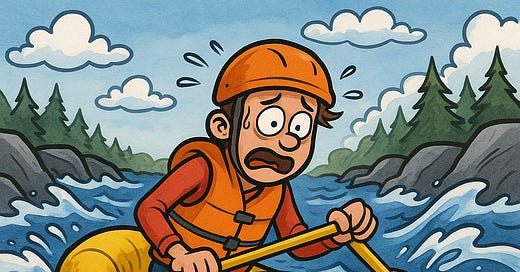Hidden rocks can sink even the strongest ships. The most dangerous ones are those you never see coming.
When Captain James Cook sailed toward Australia in 1770, on a mission to map the territory and claim it for England, he faced treacherous waters around the Society Islands—shallow reefs and hidden rocks that could tear apart his ship in an instant.
But Cook had a secret advantage: Tupaia, a Polynesian navigator who knew those waters intimately. Without Tupaia's guidance, Cook's ship might have ended up as splinters on the ocean floor.
Here's the thing: We all face our own "Society Islands" in life—territories where failure isn't just possible, it's common.
Territories Fraught With Failure Are Activities Where Failure Is Common
Building a business. Creating an online course. Learning to draw. Helping patients stick with painful but necessary physical therapy exercises.
In these domains, failure isn't the exception—it's the rule.
I worked with a physical therapist who had developed a method to get chronic pain patients to actually do their exercises (which they typically avoid because, well, they hurt). When he taught his method to other therapists, they struggled to implement it effectively.
For someone trying to figure this out alone? It would have taken a decade—just like it took him.
The Cost of Going It Alone
Think about Edmund Hillary, the first man to climb Mount Everest. Few people know that Hillary nearly died on that journey. He lost his footing and plunged into a deep crevasse, and it was his guide, Tenzing Norgay, who saved his life.
Hillary couldn't have reached the summit without Tenzing. And he definitely wouldn't have made it back alive.
When you face a territory fraught with failure, going it alone dramatically increases your chance of becoming another statistic.
Not All Guides Are Created Equal
Here's where things get tricky: Not all guides are equal, and not all successful people make good guides.
Someone might say, "I've built 10 successful businesses!" Great—they definitely know things you don't. But can they teach what they know? That's a different skill entirely.
Look for guides with a track record of helping others succeed. If someone says, "I've helped 10 out of 12 clients grow their businesses successfully," that's reversing the typical failure trend. That's the kind of guide you want.
In my own experience, I've seen the difference the right guide makes. Our course sales had gone down significantly, and we tried various methods to revive them with only limited success. It wasn't until I connected with Sean D'Souza, and learned his "Art of Pre-selling" process that we brought those course sales back up.
The right guide at the right time was exactly what I needed.
But Do You Need a Guide?
Ask yourself these questions:
Is failure common in what I'm trying to do?
Do I feel intimidated by this domain?
Have I tried learning from books or courses but still struggle?
If you answered "yes" to any of these, you probably need a guide.
And remember—a guide doesn't always mean hiring someone one-on-one. Sometimes it's a well-designed course or book. But if those resources aren't enough, consider finding your own Tenzing Norgay (Hillary’s guide on Mt. Everest).
The Difference Between Maps and GPS
The difference between good guides and mediocre ones is like the difference between having a GPS and having a map.
A good guide doesn't just show you point A and point B with some landmarks along the way. They give you turn-by-turn directions: "Turn right here, stop at this sign, watch out for this obstacle."
That level of guidance dramatically reduces your chance of failure in territories where most people don't make it.
Build Your Course with a Guide
This is exactly why I created the Atomic Course Blueprint—to be your GPS through course creation. It shows you how to make the smallest possible course that delivers real value, building your skills so you can create larger courses later.
It's not about leaving things to chance. It's about giving you a clear, specific process to follow—turning a territory fraught with failure into a journey you can successfully navigate.
Two ways I can help you
Course Builder Coaching - Want one-on-one guidance in creating a course? Book a meeting with me to see how I can help you.
The Atomic Course Blueprint - Want to create a course without the usual overwhelm? Try creating a tiny course. Find out more here.
Still here? Yay!
One thing you can do for me is reply to this email and share: What "territory fraught with failure" are you currently navigating? I'd love to hear about your journey.



